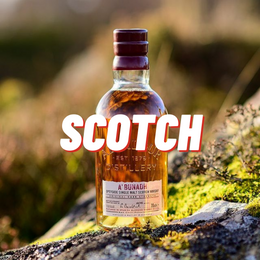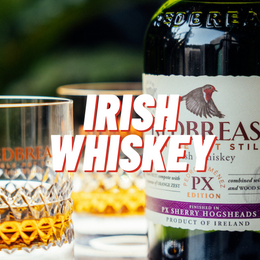
What the heck is that?
Take a good look at the labels of a couple single malt whiskies and you will commonly find words like “SHERRY CASK”, “SHERRY MATURED” or “SHERRY FINISH”.

If you have read our write-up on whisky cask styles, you would know that “sherry cask” whiskies are some of the most common kinds of whiskies. So what exactly is “sherry” and why are whisky people obsessed with it?
Sherry is a category of barrel-aged fortified wines. Authentic ones come from Spain, and are made in an area near the Spanish city of Jerez de la Frontera. They are generally between 15 to 22% ABV and there is a huge variety of styles: ranging from very dry sherry (Fino) to incredibly sweet, syrupy dessert wines (Pedro Ximénez).

Sherry is made by fermenting wine grapes, then fortifying the wine by adding grape brandy called grape brandy called destilado. The young sherry is then put into large oak barrels for maturation.
People often classify sherries according to how dry or sweet they are.
Main Styles of Sherry |
|
|
Manzanilla |
Pale, straw-colored. Delicate, light, tangy, and very dry. |
|
Fino |
Pale, straw-colored. Light in body, dry, and delicate. |
|
Amontillado |
Deep amber. Similar to Manzanilla and Fino, but richer and nuttier. |
|
Oloroso |
Dark gold to deep brown in color. Full-bodied with rich, raisiny aroma and flavor, dry. |
|
Palo cortado |
Deep amber. As rich and fragrant as Oloroso, but also delicate, light and nutty as amontillado. |
|
Pedro Ximénez |
Dark brown. Very sweet, syrupy. |
On one side of the spectrum, we have the light and bone-dry Finos and Manzanillas with complex notes that can range from almonds, sea spray and a pleasant petroleum quality. We then go on to the is medium dry Amontillados that are slightly darker and smoother with a nuttiness and notes of thyme. Olorosos and Palo cortados that are rich, full-bodied intensity with raisins and caramel. The far end of the spectrum are the Pedro Ximénezes that are intensely sweet with notes of chocolate, sticky date pudding and molasses.
Why do sherries have such different flavour profiles? This has something to do with the maturation process.

Drier and unsweet sherries (Fino and Manzanilla) are mainly matured using yeast. The yeast prevents any oxidation to the wine by forming a protective film on the wine’s surface (known as “flor”), leaving the sherry as fresh as possible. However, the yeast also consumes all of the residual sugars in the sherry, leaving it very dry, unsweet and sometimes even savoury.
More full-bodied and sweeter sherries (Oloroso and Pedro Ximénez) are mainly matured through oxidation in their barrels. This gives the sherry a heavier body, nuttier bouquet and because there is little yeast involved, leaves a lot of residual sugar in the case of Pedro Ximénez.
Who cares?
Perhaps apart from the US, the global whisky industry has a long love affair with sherry.
Iberian casks of sherry found their way to British shores during the 1700s. Scottish whisky distillers serendipitously learned that the dark, sweet remnants in the empty sherry casks could do wonders for their whisky. Unlike unflavoured oak casks, these empty sherry casks impart sweet flavours of dark fruits and nuts, giving young whisky a much more complex flavour.
Since this discovery, used sherry casks were relished by Scottish distillers and often used to mature whisky. Using some component of sherry-style maturation is almost an expectation for many distilleries. Therefore, distilleries may not even take the trouble to mention on their labels that their whisky had been matured in an ex-sherry cask.
That said, whisky distillers are constantly experimenting with different sherry styles. Recently, Springbank Distillery has revealed 5 "work-in-progress" whiskies that are being finished in different varieties of sherry casks: Pedro Ximénez, Palo Cortado, Amontillado, Fino and Manzanilla. The objective is to taste and understand the nuanced differences between various sherry cask styles.

Why should I care? How does Sherry affect my Whisky experience?
If you have drunk a whisky or two, you may already be drinking sherry-matured whiskies without even knowing it! But knowing a little about sherry helps us pinpoint flavours in our dram that derive from the sherry.
Sherry-matured whiskies tend to take on an amber red colour, and have intense sweetness, spiciness and notes of dark fruits (figs, plums, raisins, prunes and black cherries).
But not all sherry-matured whiskies are the same. They can taste very different:-
- Fino sherry casks are the least sweet, impart a leathery dry flavour notes of orchard fruits and light oak
- Oloroso sherry casks impart a moderate sweetness with some dark fruits and earthy and nutty notes
- Pedro Ximenez sherry casks impart the sweetest flavours with dark fruits, raisins and syrup

Above all, find out which types of sherry-matured whiskies you enjoy more. You may like the crisp and dry Kilchoman Fino expression. Or perhaps you may like the intense, nutty and raisiny Aberlour 13 Oloroso Cask expression. Take your time and savour the richness of your sherried whisky experiences.





